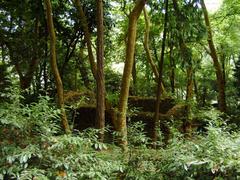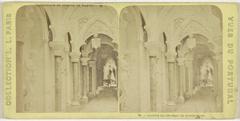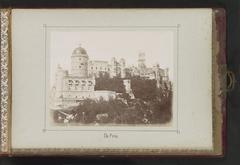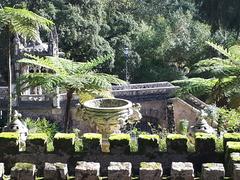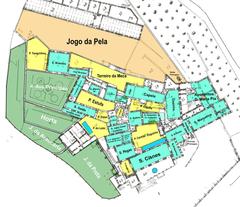Pedra Furada Halt, Sintra, Portugal: Visiting Hours, Tickets, and Travel Guide
Date: 04/07/2025
Introduction
Nestled in the enchanting landscapes of Sintra, Portugal, Pedra Furada and its associated halt offer an exceptional opportunity to experience the region’s geological marvels, rural charm, and cultural heritage. With its remarkable sandstone tubular formations dating to the Plio-Quaternary period, Pedra Furada stands out as a destination for geology enthusiasts, hikers, and travelers seeking to explore Sintra beyond the main tourist routes. The adjacent Pedra Furada Halt serves as a practical transport gateway, connecting visitors to Sintra’s tranquil countryside, scenic trails, and classified geomonuments within the Sintra-Cascais Natural Park.
This comprehensive guide provides essential information on visiting Pedra Furada and Pedra Furada Halt, including geological insights, historical context, accessibility, transport options, practical travel tips, sustainable tourism advice, and nearby attractions. Whether you are drawn by scientific curiosity, natural beauty, or cultural exploration, this resource will help you plan a memorable and responsible visit.
For in-depth geological research and cultural background, consult the ScienceDirect article on Pedra Furada and Portugal Insite’s Sintra guide.
Table of Contents
- Geological Formation and Features of Pedra Furada
- Archaeological and Historical Significance
- Visiting Pedra Furada: Hours, Tickets, and Accessibility
- Practical Tips for Tourists
- Nearby Attractions and Integration with Sintra’s Heritage
- Conservation and Visitor Experience
- Pedra Furada Halt: Transport Guide
- Accessibility and Visitor Information
- Sustainable Tourism and Responsible Travel
- Special Events and Guided Tours
- Frequently Asked Questions (FAQ)
- Visuals and Media
- Internal Links
- Access and Responsible Tourism Summary Tables
- Call to Action
Geological Formation and Features of Pedra Furada
Sedimentary Environment and Geological Context
Pedra Furada is located on the Setúbal Peninsula, just south of Lisbon and near Sintra. The site features distinctive sandstone tubes formed during the Plio-Quaternary period. These formations developed in a braided-river sedimentary environment, where alternating sand and clay layers were deposited, later cemented, and finally sculpted by erosion into the tubular structures visible today (ScienceDirect).
Morphological and Physical Characteristics
The sandstone tubes range from a few centimeters up to 30 centimeters in diameter and can extend several meters vertically. They often branch and interconnect, displaying smooth surfaces and concentric internal layers—a testament to mineral precipitation and subsequent cementation. Their resistance to erosion, compared to the surrounding rock, results in the striking, hollowed appearance that gives the site its name.
Formation Hypotheses and Scientific Investigations
Recent studies suggest that the tubes formed due to fluid escape (either water or gas) through the sediment, possibly triggered by rapid dewatering events linked to seismic activity or sediment loading. The subsequent mineral precipitation along these pathways hardened the tubes, preserving them through geologic time.
Archaeological and Historical Significance
Although renowned for its geological features, Pedra Furada is also located within a region rich in human history. The Sintra and Setúbal areas show evidence of prehistoric settlements and Roman occupation. The name “Pedra Furada” (“Pierced Stone”) reflects both the unique morphology of the formations and their significance in local folklore.
Visiting Pedra Furada: Hours, Tickets, and Accessibility
Visiting Hours and Tickets
Pedra Furada is an open natural site. There are no entrance fees or tickets required, and it is accessible throughout the year during daylight hours. For optimal weather and fewer crowds, visit in spring or autumn.
Accessibility
The terrain is uneven and rocky, with no formal paths or accessibility features. Visitors with mobility challenges should exercise caution and may require assistance. Sturdy footwear is essential due to loose rocks and inclines.
Getting There
- By Car: The site is reachable from Sintra or Lisbon by car. Use GPS coordinates or local hiking maps, as signage is limited.
- By Bicycle: Cyclists can follow rural routes from Sintra.
- Public Transport: Options are limited; private transport is generally preferable.
Practical Tips for Tourists
- Preparation: Bring water, sun protection, and clothing suitable for changing weather.
- Safety: Exercise caution on uneven terrain, especially after rainfall.
- Photography: Early and late daylight hours offer the best lighting for photos.
- Guided Visits: Occasionally organized by local geological societies—check with Sintra’s tourism office.
Nearby Attractions and Integration with Sintra’s Heritage
Pedra Furada is part of a broader network of natural and cultural attractions in Sintra:
- Castelo dos Mouros: Moorish castle with panoramic views.
- Palácio da Pena: A UNESCO-listed Romanticist palace and gardens.
- Vila Sassetti: Elegant estate with tranquil gardens.
- Sintra-Cascais Natural Park: Extensive hiking and cycling trails.
- Traditional Villages: Explore Montelavar and other rural communities for authentic local experiences (Portugal Insite).
Conservation and Visitor Experience
Pedra Furada’s sandstone formations are fragile. Visitors should avoid climbing on the tubes or disturbing the site. Help preserve the geological features by staying on established trails and packing out all litter.
Pedra Furada Halt: Transport Guide
Location and Overview
Pedra Furada Halt (Paragem/Apeadeiro de Pedra Furada) is a modest rural transport stop in the Montelavar area of Sintra, providing access to lesser-known countryside, hiking routes, and geological sites.
Bus Services
- Bus 1240 (Carris Metropolitana): Departs from central Sintra, stopping at R Liga a Pedra Furada, about a 4-minute walk from the halt. Journey time: ~34 minutes, with hourly service.
- Alternate Lines (1235, 1634): Offer connections from neighboring districts.
- Tickets: Buy onboard or at select stops; fares are €2–€4.
Train Connections
- Linha do Oeste (Comboios de Portugal): No direct train to the halt, but connections are possible via Agualva-Cacém and regional buses.
- From Sintra: Take the train to Agualva-Cacém, then transfer to a regional service towards Pedra Furada. Total travel time: ~1h 30m.
Taxi, Ride-Sharing, and Driving
- Taxi: 13–15 minutes from central Sintra, €18–€23.
- Ride-Sharing: Uber/Bolt available, often at lower rates.
- Driving: 13.4 km from Sintra’s center. Limited street parking near the halt.
Parking
- Informal street parking is available, but no dedicated lots or meters. Roads are narrow; drive with caution.
Ticketing and Real-Time Information
- Bus/Train Schedules: Moovit app, Carris Metropolitana, Comboios de Portugal (CP)
- Purchase: Onboard buses, at ticket machines, or online.
Accessibility and Visitor Information
- Mobility: Standard city buses serve the halt, but step-free access varies. Confirm with operators if accessibility is essential.
- Bicycles: Allowed on trains (outside peak hours) and buses (space permitting).
- Walking: Rural paths connect the halt to local villages and trails.
Sustainable Tourism and Responsible Travel
Pedra Furada and its halt are situated in an environmentally sensitive area. To ensure a positive impact:
- Transport: Use public transit, walk, or cycle when possible.
- Local Economy: Support local shops, eateries, and guesthouses.
- Conservation: Stay on marked trails, take all trash with you, and avoid disturbing wildlife or geological features.
- Off-Peak Visits: Minimize your impact by visiting outside summer and festival seasons.
- Community Engagement: Participate in local tours and events, and provide feedback to support ongoing improvements.
Special Events and Guided Tours
- Guided Hikes and Nature Walks: Available seasonally—check with Sintra tourism offices or community groups.
- Local Festivals: Attend rural festivals in August or other cultural celebrations for an immersive experience.
Frequently Asked Questions (FAQ)
Q: What are Pedra Furada’s visiting hours?
A: The site and halt are open year-round; natural trails are best accessed during daylight hours.
Q: Are tickets required?
A: No tickets are required for Pedra Furada or the halt itself. Public transport requires standard fares.
Q: How accessible is Pedra Furada?
A: The terrain is uneven and may challenge those with mobility concerns. The halt has basic platforms; check with operators for additional assistance.
Q: How do I get to Pedra Furada Halt?
A: Use bus 1240 from Sintra, drive, or take the train (with a transfer at Agualva-Cacém). See real-time schedules on Moovit or operator websites.
Q: Are there guided tours?
A: Local hiking groups and tourism offices may offer guided tours, especially in peak seasons.
Q: Is there parking?
A: Limited street parking is available near the halt; plan accordingly.
Visuals and Maps
- Image: Pedra Furada Halt with Sintra’s countryside in the background.
Alt text: “Pedra Furada Halt, Sintra rural transport stop with greenery and village backdrop.” - Map: Location of Pedra Furada Halt in relation to Sintra and bus routes.
Alt text: “Map highlighting Pedra Furada Halt and bus line 1240 route from Sintra center.”
Internal Links
Summary Table: Access Options to Pedra Furada Halt
| Mode | Route/Operator | Duration | Frequency | Cost (2025) | Notes |
|---|---|---|---|---|---|
| Bus | 1240 (Carris Metropolitana) | 34 min | Hourly | €2–€4 | Direct, most convenient |
| Bus | 1235, 1634 | Varies | Less frequent | €2–€4 | Alternative routes |
| Train+Bus | CP + Carris Metropolitana | 1h 30m | Varies | €2–€24 | Requires transfer at Agualva-Cacém |
| Taxi/Uber | Local operators | 13 min | On demand | €18–€23 | Fastest, most expensive |
| Car | Self-drive | 13 min | N/A | €1–€3 (fuel) | Parking available; roads can be narrow |
Always check Moovit, Rome2Rio, or Carris Metropolitana for current schedules and fares.
Sustainable Tourism: Summary Table
| Action | Impact | How to Implement |
|---|---|---|
| Use public transport | Reduces emissions, traffic, and noise | Arrive by train; use local buses or walk/cycle |
| Support local businesses | Boosts rural economy, preserves traditions | Buy crafts, eat local, stay in village lodgings |
| Respect geological sites | Preserves scientific and scenic value | Stay on paths, don’t remove rocks or plants |
| Minimize waste | Protects landscape and wildlife | Pack out all trash, use reusable containers |
| Visit off-peak | Reduces crowding and pressure on resources | Travel outside summer and festival periods |
| Engage with community | Fosters cultural exchange and stewardship | Attend events, use local guides, give feedback |
Call to Action
Plan your journey to Pedra Furada and its halt for an enriching blend of geology, culture, and sustainable adventure. Download the Audiala app for real-time travel updates, detailed guides, and insider tips. Follow us on social media for the latest event announcements and expert recommendations.
References
- ScienceDirect article on Pedra Furada
- Carris Metropolitana
- Moovit app
- Rome2Rio
- Portugal Insite’s guide
- Comboios de Portugal (CP) website


